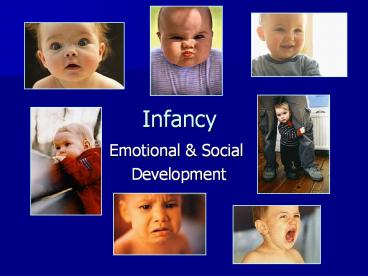Infancy - PowerPoint PPT Presentation
Title:
Infancy
Description:
Happiness (6-10 wks) promotes bonding (social smiling) ... Harlow & Zimmerman (1959) rhesus monkey studies suggested something else... – PowerPoint PPT presentation
Number of Views:41
Avg rating:3.0/5.0
Title: Infancy
1
Infancy
Emotional Social Development
2
Emotional Development
- Basic emotions are universal, suggesting
evolutionarily adaptive - Emotions develop in a sequence
- Happiness (6-10 wks) promotes bonding (social
smiling) - Anger (4-6 mo) allow infant to assert themselves
- Fear (6-8 mo) keeps infants safe (stranger
anxiety) - Social referencing (7-10 mo) fosters learning
But, do some infants have specific patterns of
emotion?
3
Temperament
- Stable individual differences in quality
intensity of emotional reactions, activity,
attention - Thomas Chess( 1956)
- Participants 141 infants followed from early
infancy to adulthood - Method parents rated child on 9 dimensions
Type
35 were not categorized!
Easy
40
Difficult
10
Slow-to-warm up
15
4
- Is temperament stable?
- Low to moderate stability
- More stable after 2yrs
- Is it genetic or influenced by environment?
- Twin studies, cultural gender differences
provide strong support for genetics - Environment matters too Goodness-of-fit Model
Infants Temperament
5
Eriksons Psychosocial Lifespan Theory of
Personality
- Personality is an interaction between
psychological (inner) maturation societal
demand - 8 psychosocial stages of personality development
- Crisis of opposing tendencies to be resolved
- If successful, acquire personality strength
- Epigenetic principle sequence biologically
fixed, but social context influences how crisis
is resolved
6
Stages of Personality Development
If trust autonomy not acquired, developmental
problems later
7
Attachment
- Why do infants become attached to caregivers?
- Early theories suggested feeding
- Harlow Zimmerman (1959) rhesus monkey studies
suggested something else
8
(No Transcript)
9
(No Transcript)
10
(No Transcript)
11
Ethological theory of attachment J. Bowlby
- Promotes survival by keeping parent close
- Clear-cut attachment (6-8 months to 18mo-2yrs)
infants develop separation anxiety - Use caregiver as a secure base for exploration
- An internal-working-model develops is the
foundation for future relationships
How do we measure attachment?
12
Strange Situation
13
Attachment Patterns
Pattern Exploration/Alone/Return
Secure attachment
Secure base/may cry/comforted
Avoidant
Ambivalent/not distressed/avoid
Resistant
Cling/distressed/angry or resist
Disorganized/disoriented
Some exploration/cry/confused
How common are these patterns?
14
Prevalence of attachment patterns































